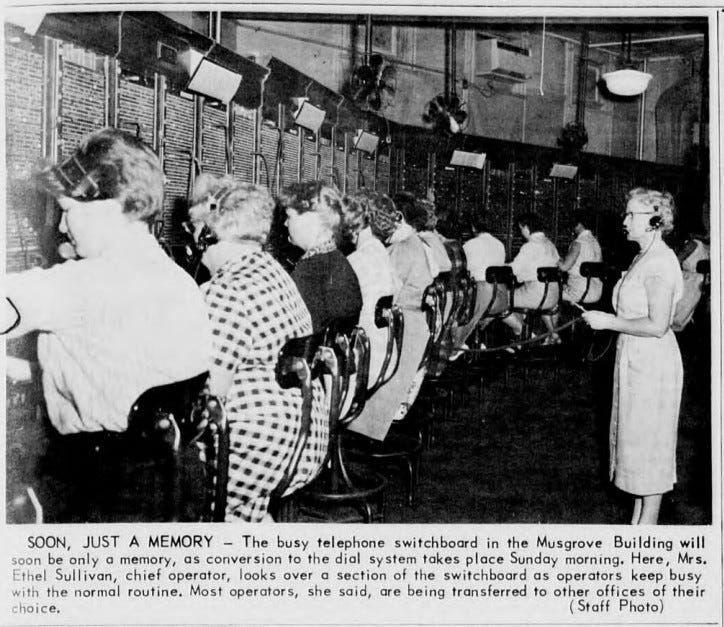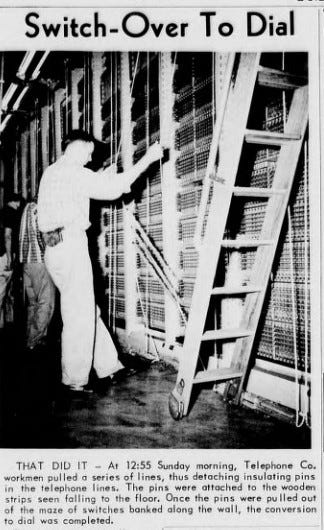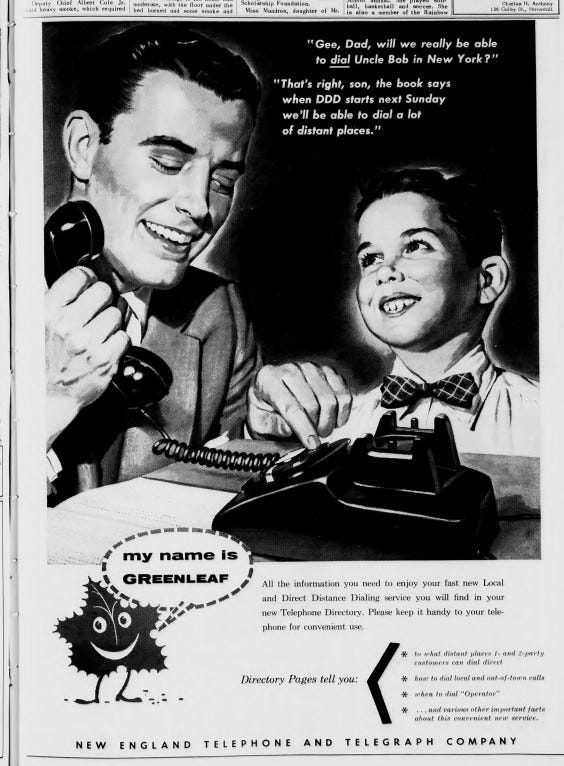A seminal event in telephone history
Competition flooded the market place and the number of telephones exploded. The telephone moved from novelty to necessity.
If you’re a subscriber to the Buzz, thank you! If you’re new here, or you haven’t become a subscriber yet, hit that subscribe button to have History Buzz delivered directly to your inbox. If you can, please consider a paid subscription to support the research and writing that make History Buzz possible.
Adapted from a January 18, 2018 Andover Townsman article written by Tom Adams.
Since its incorporation in 1646, Andover has embraced the impacts of life-changing technology. The incandescent bulb brought light to our homes. Central heating made our homes more comfortable. Telegraphs and radio began to shrink our world. And the mobility of the automobile brought the wider-world ever closer.
In the late 19th and early 20th centuries, Andover was enjoying the afterglow of remarkable economics growth, innovation, and expansion. The mills were booming. Employment was strong. Local movie houses featured films by D. W. Griffith with stars like Mary Pickford and Tom Mix. Other venues offered theatre, dancing, and entertainment. People were enjoying inventions such as traffic lights, refrigerators and gas stoves. Alexander Graham Bell’s new telephone, while imagination-stirring, was considered a passing novelty. It quickly turned out to be far more lasting.
Several key patents held by American Telephone and Telegraph Company expired in 1894. It was a seminal event. Competition flooded the market place and the number of telephones exploded. The telephone moved from novelty to necessity.
At first, the telephone lines were separate lines that connected pairs of telephones. In other words, each person that had a telephone could talk to one other telephone. The first telephone line was set up in Boston in 1877. It connected the home of Charles Williams Jr.1
From the January 1897 Townsman,
Improvements are being made in the private phone service between Marland, North Andover and Haverhill Mills on M.T. Stevens and Sons. Poles along the highways are being relocated about 33 to the mile and an extra wire is being laid. The work is being done by E.S. Edmunds who has set 250 poles and has about 40 more to locate.
The story of the first recorded telephone in Andover is one of great drama.
The situation escalated to such a degree that a headline in the June 11,1897 Andover Townsman read,
“now comes a telephone war in Andover ‘twixt the druggist and the milliner and the heavy guns are all in play.”
The telephone (yes, you read that right, one telephone) was first located in the business of Brown and Shattuck, hatmakers at 5 Main St. Its presence was desired at Allen’s Drug Store, and plans were made to transfer the phone station. Unfortunately, Mrs. Thomas Murphy had recently purchased the business location at 5 Main St, and was upset to discover the telephone would not be included in the buy. As a result, a petition asking that the telephone remain at 5 Main St was signed by nearly all the townsmen and presented to the management of the telephone company.
Some two months later, the newspaper happily reported that,
“the telephone station will stay at its present quarters and as a compromise another station will be made at Allen’s drugstore. With two stations in the center of town there should be no more complaints in regard to the service given by the company.”
Quite the ruckus, but a telephone was the fancy new technology back then, and everyone wanted a piece!
By 1899, the Andover telephone exchange had over 60 subscribers. It was newsworthy. However, the public telephone continued to move between drugstores in downtown Andover. The Aug. 12, 1898 Andover Townsman noted that, “The public telephone has been removed from George Carlyle’s store this week and placed in the drug store of Arthur Bliss." By 1900, Andover had 75 subscribers.
By 1907, the United States had an extensive system of six million telephones with service available practically anywhere in the country. Public (pay) phones were more readily available – some were actually staffed with a clerk to collect the money for your call!
By 1908 there were 12 public stations around town including the Phillips (now Andover) Inn and at the Boston & Maine railroad station. The supply of new telephone equipment increased over time allowing more and more private residences to install service. New England Telephone & Telegraph, Andover’s arm of Ma Bell, even offered a "trial" telephone to first-time customers promising the convenience, practicality, and affordability of having their own telephone.
Complicated rate structures
The public, however, grappled with complicated rate structures. A long, drawn-out battle ensued between the town and Ma Bell addressing rate inequities. With business flourishing in Lawrence, they argued over the cost of tolls charged for calling Lawrence exchanges. Point and counter-point, the debate went back-and-forth for months.
The early 1940s brought an even bigger challenge. World War II and the needs of the war effort profoundly impacted the telephone business and the availability of their product. Redirecting key components, like the copper used in the manufacture of telephones along with AT&T’s network-design expertise, greatly reduced the supply of new equipment and the development of additional infrastructure.
Party lines, phone numbers shared by multiple households, became more prevalent. While presenting their users with its set of challenges, party lines helped keep new service available during the war. Those sacrifices ultimately paid off, our veterans came home and a period of unprecedented prosperity and growth began.
Roll out of new rotary dial in 1958 brought the end of the switchboard operator.
Newspaper articles described the roll out for Andover’s 6,600 telephones that happened at 1:01am on Sunday, August 17, 1958. The new exchange was “Greenleaf,” so callers dialed GR before the five-digit number they were calling. An “intercept” operator was available to assist and instruct those who needed help.
At about 1a.m., unless emergency calls are being placed through the switchboard in the Musgrove building, other callers will be asked to hang up. Mrs. Ethel Sullivan, chief opertor, will signal the dial building on Elm Street that the lines are cleared before the new dial equipment becomes effective, the old lines running into the Musgrove building will be severed – so for a brief interval the town will be practically out of touch with the world.
Seconds later, men stationed throughout the dial building will pull master ropes, to which are attached thousands of small pins which have prevented the new lines from operating, when these are removed, the dial tone will hum and the town will have been converted.
Mr. Chicoine predicted a heavy load of calls Sunday morning as many resident “try out’ the new system. But the load should be back to normal Sunday night, he stated. (August 14, 1958)
As reported in the next issue of the Townsman, August 21, 1958, 21,000 calls when through the new dial system. A few difficulties were reported, but the intercept operators received only a few “wrongly-dialed numbers.”
The telephone’s story is far from over. It continues to evolve, connecting people in their daily lives. Party lines are a thing of the past and with the explosive growth of the cell phone, land lines are likewise becoming passé. As of 2023, there were almost 8.98 billion cell phone subscribers worldwide. There are 7 billion people on earth. That evolution took 20 years. One can only imagine what changes the next 20 years will bring.
How about you? Do you have memories of party lines and operators? Or maybe a dial phone is a quaint relic from the distant past? Leave a comment and let us know your story. We love hearing from you!
Thanks for reading!
Tom and Elaine
If you enjoyed this post, please consider becoming a subscriber - or a paid subscriber for $5/month to support the research ans writing that makes History Buzz possible.










I remember our first phone number was 122M. We did not use the phone often, but one day I decided to call my friend George Rennie who lived down the street. The operator said, "Does your mother know you are using the phone?" I said no! but she placed the call anyway.
I remember when we went to dial. I was at a Red Sox game in Boston with my Dad. It was Shriners Day, and yes, Ted Williams was playing. I was more excited to get home and try the phone, than watch the game that day. I was so disappointed when we arrived home to find the phone company had not showed up to install the new phone. Now you tell me it was Sunday! That figures! I also remember that the folks that lived out on River Road all had a Lawrence exchange, Mudrock 3, and of course two of my best friends live out there. Long distance my foot!
I remember dial tones. And being tethered to a wall. My great aunt's Belmont phone number was copied into the family phone book with its exchange. I had to ask mom and dad for the first two numbers.
Do I miss being tethered to a wall? Hades no. But I "may have" started to indicate my number as a landline so I dont get blitzed with automated texts I dont want.